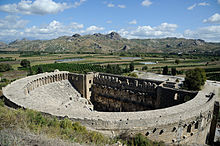Roman Theatre of Aspendos
 View of the Roman Theatre of Aspendos in 2011 | |
| Location | Aspendos, Turkey |
|---|---|
| Coordinates | 36°56′20″N 31°10′20″E / 36.93889°N 31.17222°E |
| Type | Roman theatre |
| Width | 96 metres (315 ft) |
| History | |
| Builder | Zenon |
| Founded | 161 a.D - 180 a.D |
| Abandoned | No |
| Periods | Ancient Rome |
| Cultures | Roman |
| Site notes | |
| Condition | Almost intact |
| Public access | Yes |
The Roman theater of Aspendos is a Roman theater in the ancient city of Aspendos in Turkey. It was built in the 2nd century and is one of the best preserved ancient theaters of the Greco-Roman world.[1]
Description[edit]
With a diameter of 96 metres (315 ft), the theatre provided seating for 7,000/13,000 people. The theatre was built in 155 AD by the Greek architect Zenon, a native of the city, during the rule of Marcus Aurelius. It was periodically repaired by the Seljuks, who used it as a caravansary, and in the 13th century the stage building was converted into a palace by the Seljuks of Rum. Technically the structure is a theatre not an amphitheatre, the latter being fully round or oval shaped.
History[edit]
The theater was built during the reign of Marcus Aurelius (161-180). An inscription lists the brothers Curtius Crispinus and Curtius Auspicatus as commissioners and Zenon as architect. The cavea is partly built against theslope of the hill, which provides a natural foundation. The rest of the stand rests on stone arcades. The cavea has 41 rows of benches, providing seating for 12,000 spectators. The stage wall is completely intact, only the original eight-meter-deep wooden ceiling has disappeared. Around the theater, 58 holes have been found where there used to be poles, which could be used to stretch a large velarium over the grandstand to protect the spectators from the sun.[2]
In the 13th century, the stage building was converted into a palace for the Seljuks.
In modern times, the theater has been restored to its original state. It is an important tourist attraction for the region. In spring and summer, opera and ballet performances are held there.
See also[edit]
References[edit]
- ^ Andreae, Bernard (1977). The Art of Rome. New York: H. N. Abrams. p. 567. ISBN 0-8109-0626-0.
The Roman theater survives virtually intact... scarcely another surviving theater gives a better impression of just how the Roman theater - a solid single unified structure - differed from the Greek theater, which was made up of separate structures juxtaposed but each isolated and complete in itself.
- ^ "Theatre in Aspendos | Turkish Archaeological News". turkisharchaeonews.net. Retrieved 2023-10-21.
External links[edit]
- History of Aspendos
- Aspendos photos folder
- Maps of Aspendos
- How to go to Aspendos
- Plan of the Aspendos Antic Theater
- The Theatre at Aspendos, The Ancient Theatre Archive, Theatre specifications and virtual reality tour of theatre
- Livius.org: Aspendus
- Aspendos html5/full screen panoramas taken December, 2012
- Over 350 pictures from several visits
- Aspendos Archaeological Project 2008 –
- Top Ten Best Historical Places in Turkey including Aspendos checkout more detail

